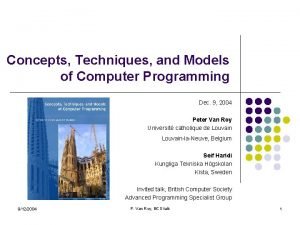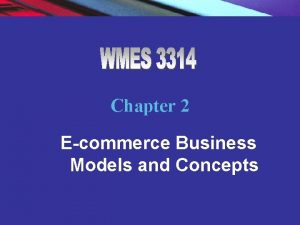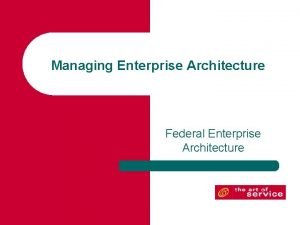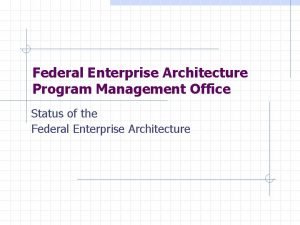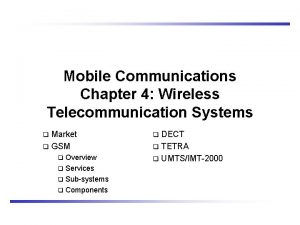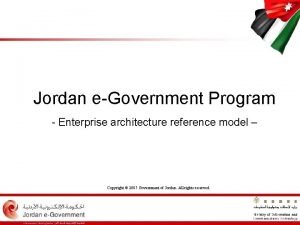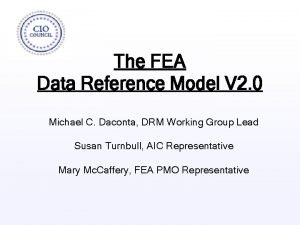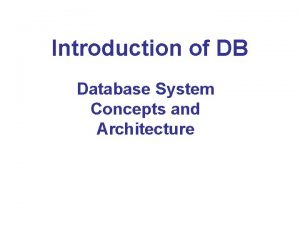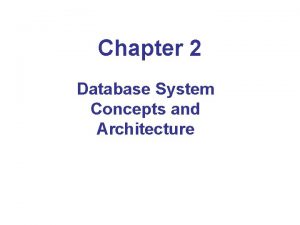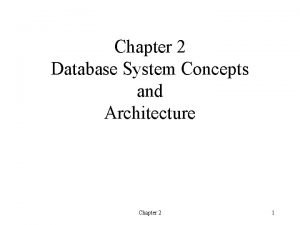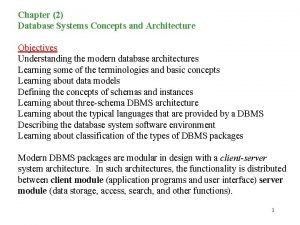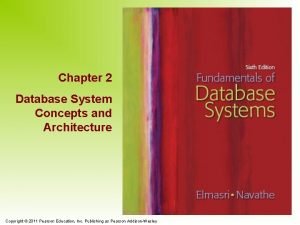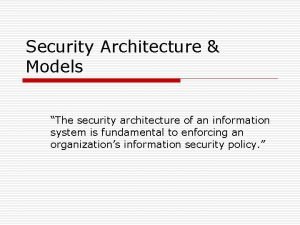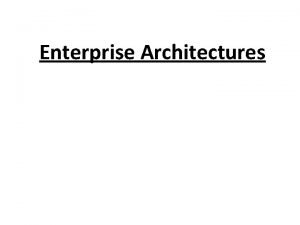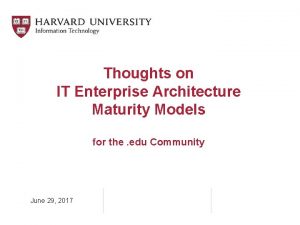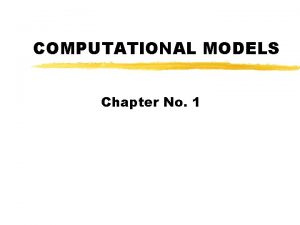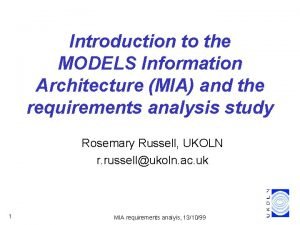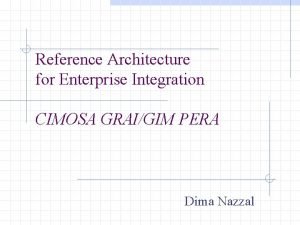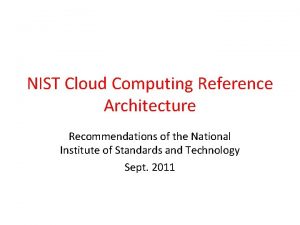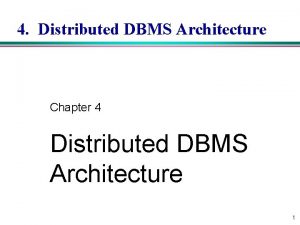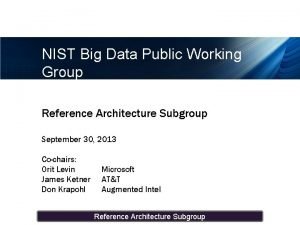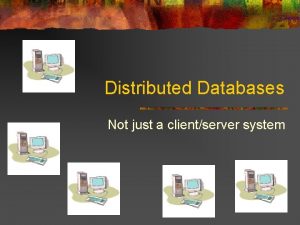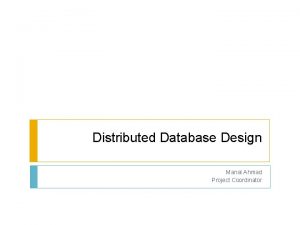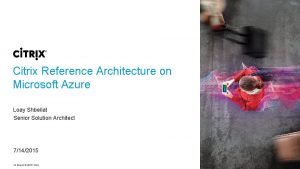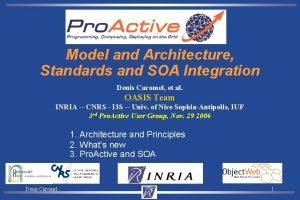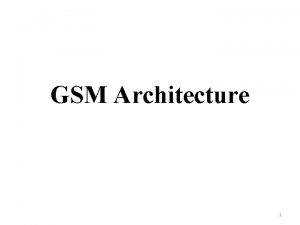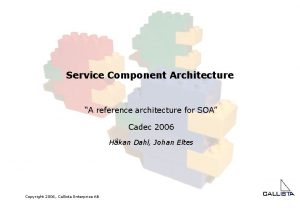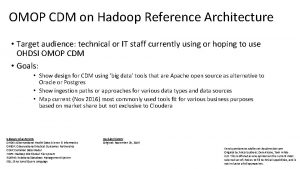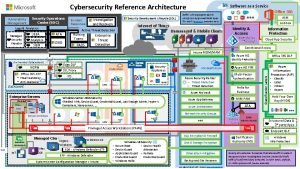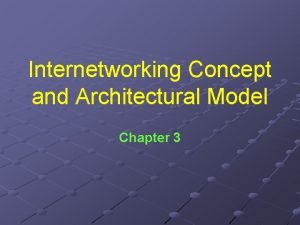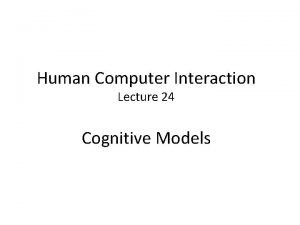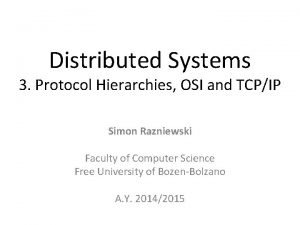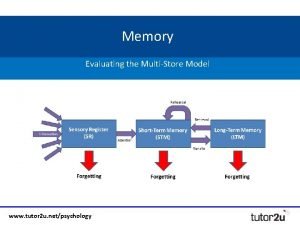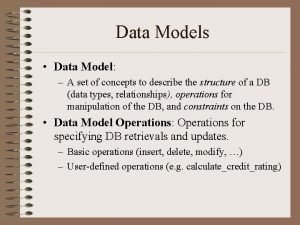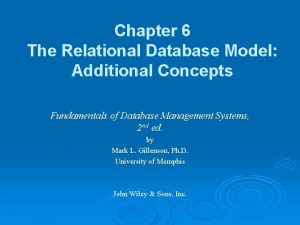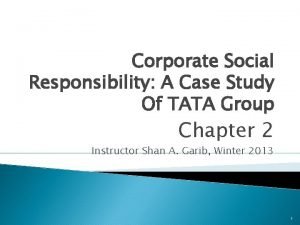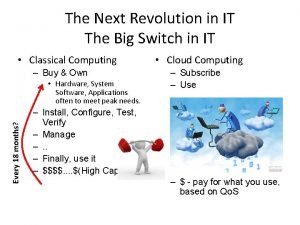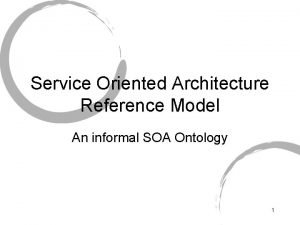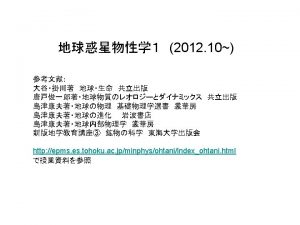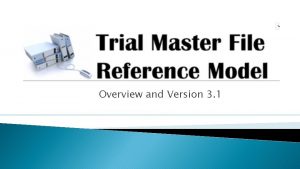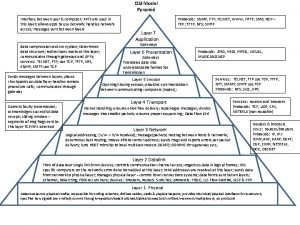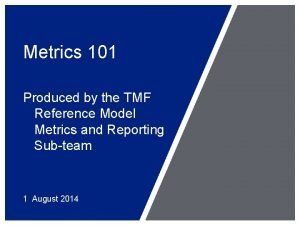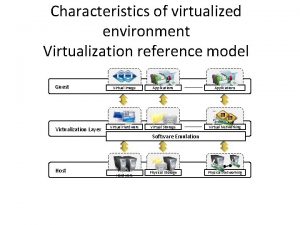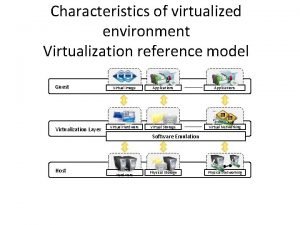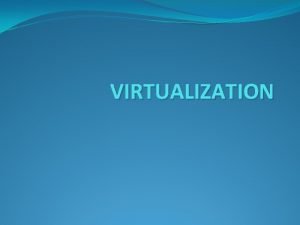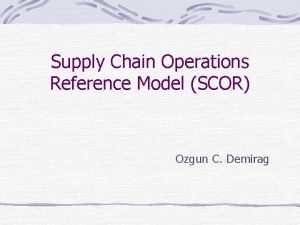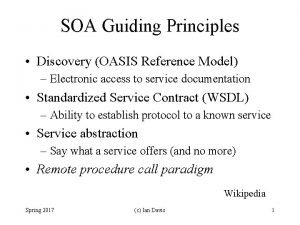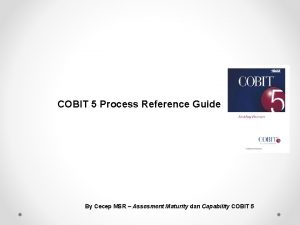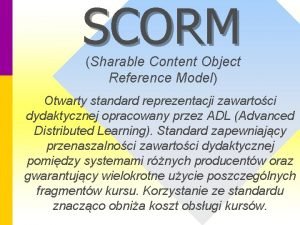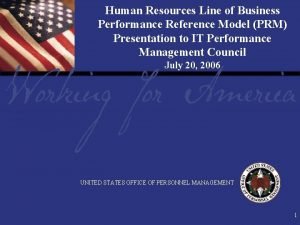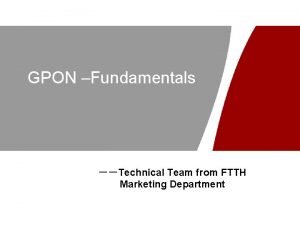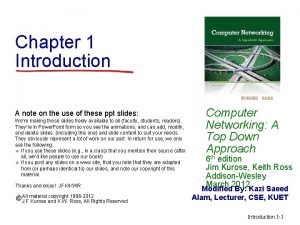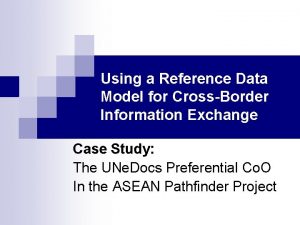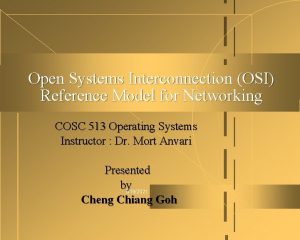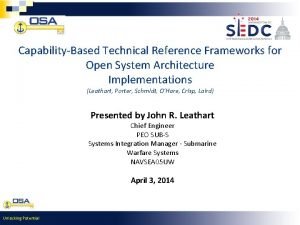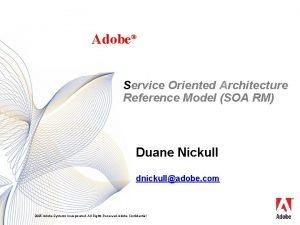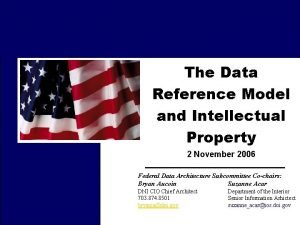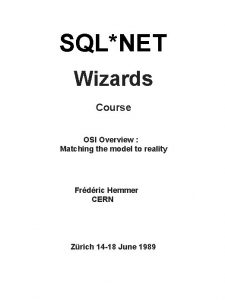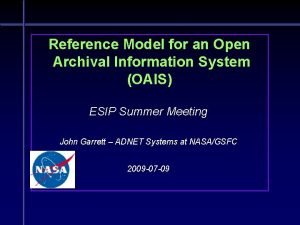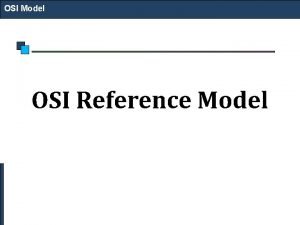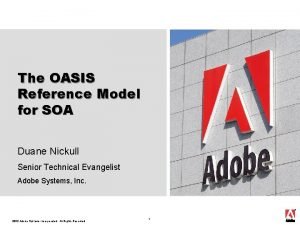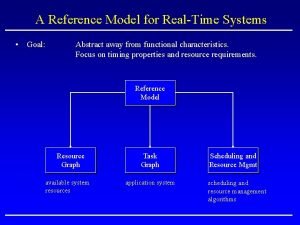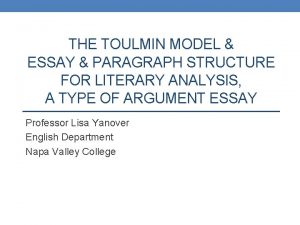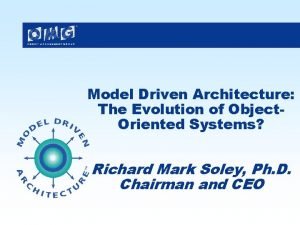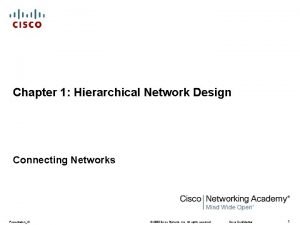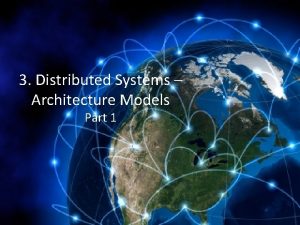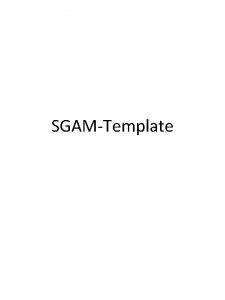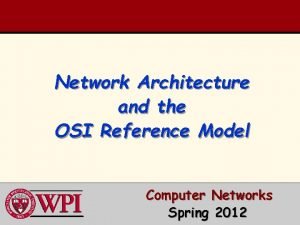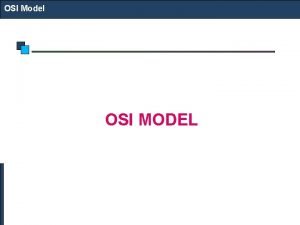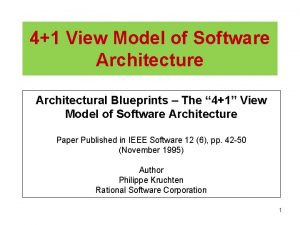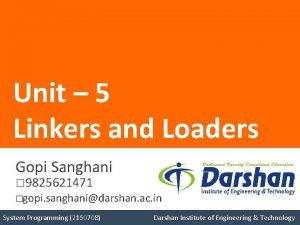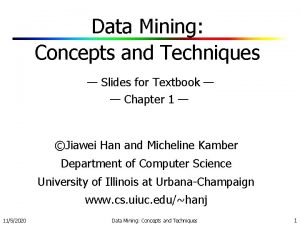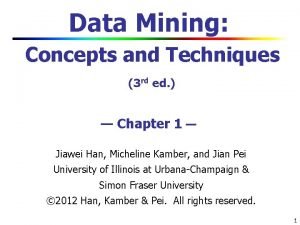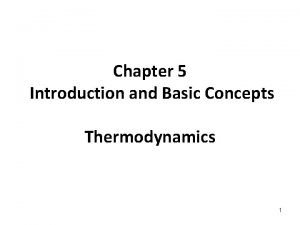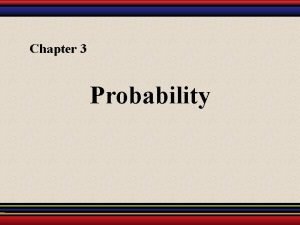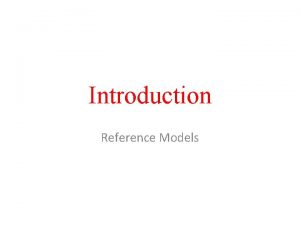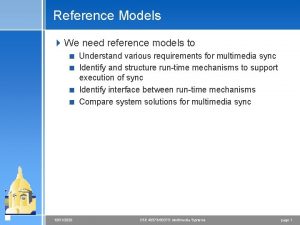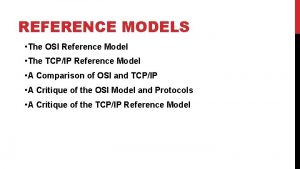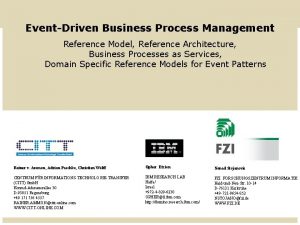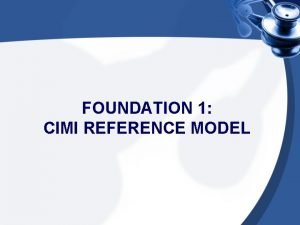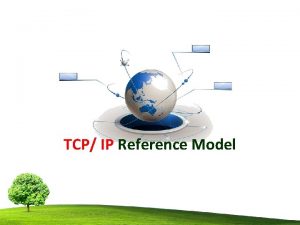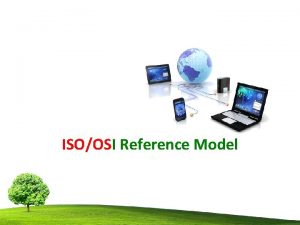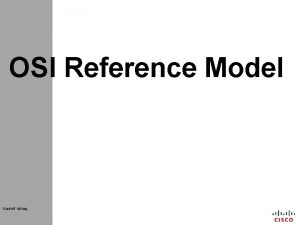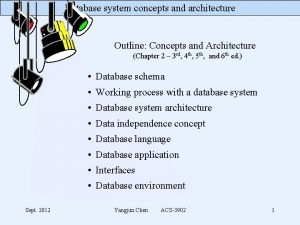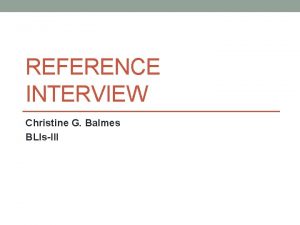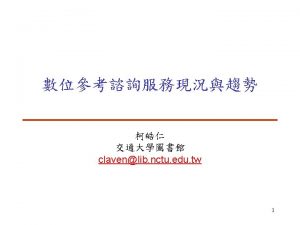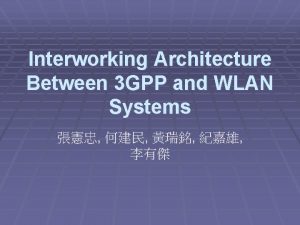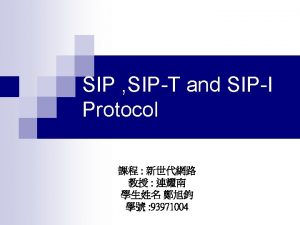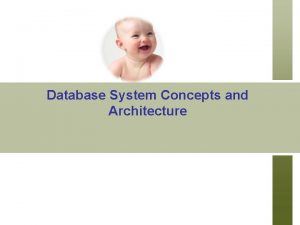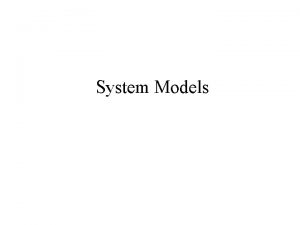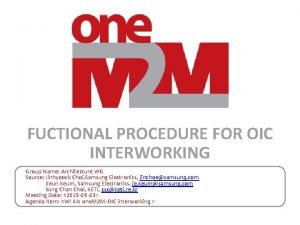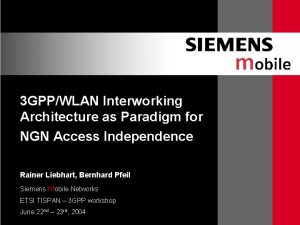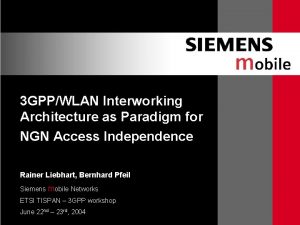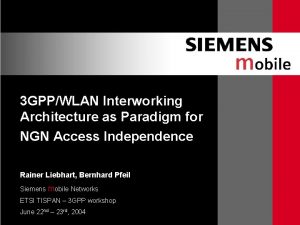Outline Architecture Model and Concepts Reference models Interworking
















































































































- Slides: 112


Outline • Architecture Model and Concepts – Reference models – Interworking with EPC • Network Functions – Functional descriptions – Services • Control and User Plane Protocol Stacks – Control Plane Protocol Stacks – User Plane Protocol Stacks References: • TS 23. 501: System Architecture for the 5 G System • Journal of Information and Communication Technology, Vol. 6, River Publishers, 2018 2

5 G System • 5 G System: 3 GPP system consisting of 5 G Access Network (AN), 5 G Core Network and UE – 5 G Access Network: An access network comprising a NG-RAN and/or non-3 GPP AN connecting to a 5 G Core Network. • NG-RAN: A radio access network that supports one or more of the following options with the common characteristics that it connects to 5 GC 1) Standalone New Radio 2) New Radio is the anchor with E-UTRA extensions 3) Standalone E-UTRA 4) E-UTRA is the anchor with New Radio extensions – 5 G Core Network: The core network specified in the present document. It connects to a 5 G Access Network • 5 G Qo. S Flow: The finest granularity for Qo. S forwarding treatment in the 5 G System. All traffic mapped to the same 5 G Qo. S Flow receive the same forwarding treatment (e. g. scheduling policy, queue management policy, rate shaping policy, RLC configuration, etc. ). Providing different Qo. S forwarding treatment requires separate 5 G Qo. S Flow • 5 G Qo. S Identifier: A scalar that is used as a reference to a specific Qo. S forwarding behaviour (e. g. packet loss rate, packet delay budget) to be provided to a 5 G Qo. S Flow. This may be implemented in the access network by the 5 QI referencing node specific parameters that control the Qo. S forwarding treatment (e. g. scheduling weights, admission thresholds, queue management thresholds, link layer protocol configuration, etc. ) 3

Network Slice and Functions • Network Slice: A logical network that provides specific network capabilities and network characteristics – Network Slice instance: A set of Network Function instances and the required resources (e. g. compute, storage and networking resources) which form a deployed Network Slice – NSI ID: an identifier for a Network Slice instance • Network Function (NF): A 3 GPP adopted or 3 GPP defined processing function in a network, which has defined functional behaviour and 3 GPP defined interfaces – Network Instance: Information identifying a domain. Used by the UPF for traffic detection and routing – NF instance: an identifiable instance of the NF – NF service: a functionality exposed by a NF through a service based interface and consumed by other authorized NFs • NF service instance: an identifiable instance of the NF service. • NF service operation: an elementary unit a NF service is composed of – Service based interface: It represents how a set of services is provided/exposed by a given NF 4

5 G Architecture Model and Concepts • The 5 G System architecture is defined to support data connectivity and services enabling deployments to use techniques such as e. g. – Network Function Virtualization and – Software Defined Networking • The 5 G System architecture shall leverage servicebased interactions between Control Plane (CP) Network Functions where identified 5

Key Principles and Concepts • Separate the User Plane (UP) functions from the Control Plane (CP) functions – allowing independent scalability, evolution and flexible deployments e. g. centralized location or distributed (remote) location • Modularize the function design – e. g. to enable flexible and efficient network slicing. • Wherever applicable, define procedures as services, so that their re-use is possible – i. e. the set of interactions between network functions • Enable each Network Function to interact with other NF directly if required – Does not preclude the use of an intermediate function to help route CP messages (e. g. like a Diameter Routing Agent (DRA)) • Minimize dependencies between Access Network (AN) and Core Network (CN) – Defined with a converged core network with a common AN - CN interface which integrates different Access Types e. g. 3 GPP access and non-3 GPP access • Additional supports – – A unified authentication framework "stateless" NFs, where the "compute" resource is decoupled from the "storage" resource Capability exposure Concurrent access to local and centralized services. To support low latency services and access to local data networks, UP functions can be deployed close to the Access Network – Roaming with both Home routed traffic as well as Local breakout traffic in the visited PLMN 6

Architecture for the 5 G System • The 5 G architecture is defined as service-based – Network functions within the 5 GC Control Plane shall only use service-based interfaces for their interactions • Interaction between network functions is represented in two ways – A service-based representation • Where network functions (e. g. AMF) within the Control Plane enables other authorized network functions to access their services • This representation also includes point-to-point reference points where necessary – A reference point representation • Shows the interaction exist between the NF services in the network functions described by point-to-point reference point (e. g. N 11) between any two network functions (e. g. AMF and SMF) Service-based interfaces are listed in clause 4. 2. 6. Reference points are listed in clause 4. 2. 7 7

5 G Network Functions • Authentication Server Function (AUSF) • Access and Mobility Management Function (AMF) • Data Network (DN) – e. g. operator services, Internet access or 3 rd party services • • • • Unstructured Data Storage Function (UDSF) Network Exposure Function (NEF) Network Repository Function (NRF) Network Slice Selection Function (NSSF) Policy Control Function (PCF) Session Management Function (SMF) Unified Data Management (UDM) Unified Data Repository (UDR) User Plane Function (UPF) Application Function (AF) User Equipment (UE) (Radio) Access Network ((R)AN) 5 G-Equipment Identity Register (5 G-EIR) Security Edge Protection Proxy (SEPP) Network Data Analytics Function (NWDAF) 8

5 G System Architecture (n. R-SB, Non-Roaming Service-Based) Network Slice Selection Function Network Exposure Function Network Repository Function AUthentication Server Function User Equipment Policy Control Function Access and Mobility Management Function (Radio) Access Network Unified Data Application Management Function Session Management Function User Plane Function Data Network The non-roaming reference architecture with service-based interfaces used within the Control Plane 9

5 G System Architecture (n. R-RP, Non-Roaming Reference Point) The non-roaming reference architecture with the reference point representation showing how various network functions interact with each other (For clarity, some NFs are not depicted) 10

5 G n. R-RP Architecture for Accessing Two DNs with Multiple PDU Sessions UEs concurrently access two (e. g. local and central) data networks using multiple PDU sessions where two SMFs are selected for the two different PDU Sessions (each SMF may have capability to control both a local and a central UPF within a PDU Session) 11

5 G n. R-RP Architecture for Accessing Two DNs with a Single PDU Session UEs concurrently access two (e. g. local and central) data networks using a single PDU session 12

n. R-RP Architecture for Network Exposure Function Southbound Interfaces • Trust domain for NEF is same as Trust domain for SCEF as defined in TS 23. 682 • Southbound interfaces between NEF and 5 GC Network Functions, e. g. N 29 interface between NEF and SMF, N 30 interface between NEF and PCF 13

5 G System Architecture (Rm-SB, Roaming Service-Based) Network Slice Network Policy Selection Exposure Repository Control Application Function Function Access and Mobility Management Function User Equipment (Radio) Access Network Session Management Function Unified Data Management Security Edge Protection AUthentication Proxy Server Function User Data Plane Network Function The roaming reference architecture with local breakout using service-based interfaces within the Control Plane 14

5 G System Architecture - Home Routed Scenario (Rm-SB, Roaming Service-Based) 15

5 G System Architecture (Rm-RP, Roaming Reference Point) The roaming reference architecture in the case of local breakout scenario using the reference point representation 16

5 G System Architecture - Home Routed Scenario (Rm-RP, Roaming Reference Point) 17

NRF Roaming Architecture in Reference Point Representation • For the roaming scenarios described above each PLMN implements proxy functionality to secure interconnection and hide topology on the inter-PLMN interfaces 18

Data Storage Architectures for Unstructured Data from any NF • The 5 G System architecture allows any NF to store and retrieve its unstructured data into/from a UDSF (e. g. UE contexts) – The UDSF belongs to the same PLMN where the network function is located – CP NFs may share a UDSF for storing their respective unstructured data or may each have their own UDSF (e. g. a UDSF may be located close to the respective NF) 19

Data Storage Architecture • The 5 G System architecture allows the UDM, PCF and NEF to store data in the UDR, including – subscription data and policy data by UDM and PCF, – structured data for exposure and – application data (including Packet Flow Descriptions (PFDs) for application detection, AF request information for multiple UEs) by the NEF 20

Functions of UDR can be deployed in each PLMN and it can serve different functions as follows • UDR accessed by the NEF belongs to the same PLMN where the NEF is located • UDR accessed by the UDM belongs to the same PLMN where the UDM is located if UDM supports a split architecture • UDR accessed by the PCF belongs to the same PLMN where the PCF is located 21

Nudr Interface • The Nudr interface is defined for the network functions (i. e. NF Service Consumers), such as UDM, PCF and NEF, to access a particular set of the data stored and to read, update (including add, modify), delete, and subscribe to notification of relevant data changes in the UDR • Each NF Service Consumer accessing the UDR, via Nudr, shall be able to add, modify, update or delete only the data it is authorised to change – This authorisation shall be performed by the UDR on a per data set and NF service consumer basis and potentially on a per UE, subscription granularity • The following data in the UDR sets exposed via Nudr to the respective NF service consumer and stored shall be standardized: – Subscription Data – Policy Data – Structured Data for exposure – Application data: Packet Flow Descriptions (PFDs) for application detection and AF request information for multiple UEs, as defined in clause 5. 6. 7 22

Service-based Interfaces • Namf: • Nsmf: • Nnef: • Npcf: • Nudm: • Naf: • Nnrf: • Nnssf: • Nausf: • Nudr: • Nudsf: • N 5 g-eir: • Nnwdaf: Service-based interface exhibited by AMF Service-based interface exhibited by SMF Service-based interface exhibited by NEF Service-based interface exhibited by PCF Service-based interface exhibited by UDM Service-based interface exhibited by AF Service-based interface exhibited by NRF Service-based interface exhibited by NSSF Service-based interface exhibited by AUSF Service-based interface exhibited by UDR Service-based interface exhibited by UDSF Service-based interface exhibited by 5 G-EIR Service-based interface exhibited by NWDAF 23

Fundamental Reference Points • The 5 G system architecture contains the following reference points: – N 1: Reference point between the UE and the AMF – N 2: Reference point between the (R)AN and the AMF – N 3: Reference point between the (R)AN and the UPF – N 4: Reference point between the SMF and the UPF – N 6: Reference point between the UPF and a Data Network – N 9: Reference point between two UPFs 24

NF-Interaction Reference Points • These reference points are realized - by corresponding NF service-based interfaces and - by specifying the identified consumer and producer NF service as well as their interaction in order to realize a particular system procedure – – – N 5: Reference point between the PCF and an AF N 7: Reference point between the SMF and the PCF N 8: Reference point between the UDM and the AMF N 10: Reference point between the UDM and the SMF N 11: Reference point between the AMF and the SMF N 12: Reference point between AMF and AUSF N 13: Reference point between the UDM and Authentication Server function the AUSF N 14: Reference point between two AMFs N 15: Reference point between the PCF and the AMF in the case of non-roaming scenario, PCF in the visited network and AMF in the case of roaming scenario N 16: Reference point between two SMFs, (in roaming case between SMF in the visited network and the SMF in the home network) N 17: Reference point between AMF and 5 G-EIR 25

NF-Interaction Reference Points (Cont. ) – N 22: Reference point between AMF and NSSF – N 23: Reference point between PCF and NWDAF – N 24: Reference point between the PCF in the visited network and the PCF in the home network – N 27: Reference point between NRF in the visited network and the NRF in the home network – N 31: Reference point between the NSSF in the visited network and the NSSF in the home network – N 32: Reference point between SEPP in the visited network and the SEPP in the home network – N 33: Reference point between NEF and AF – N 34: Reference point between NSSF and NWDAF – N 35: Reference point between UDM and UDR – N 36: Reference point between PCF and UDR – N 37: Reference point between NEF and UDR – N 40: Reference point between SMF and the CHF – N 50: Reference point between AMF and the CBCF 26

Relationship between Service-Based Interfaces and Reference Points • A Reference Point is a conceptual point at the conjunction of two nonoverlapping functional groups (see TR 21. 905) • A reference point can be replaced by one or more service-based interfaces which provide equivalent functionality Example show a Reference Point replaced by two Service based Interfaces Example show a Reference Point replaced by a single Service based Interface 27

Reference Points vs. Service-based Interfaces Representation of Equal Functionality on the Interfaces • Reference points exist between two specific Network Functions – Even if the functionality is equal on two reference points between different Network Functions there has to be a different reference point name – Using the service-based interface representation it is immediately visible that it is the same service-based interface and that the functionality is equal on each interface 28

One or More Services Exposed by One Network Function 29

Support of Non-3 GPP Access • The 5 G Core Network supports the connectivity of the UE via non-3 GPP access networks, e. g. WLAN access – Only the support of non-3 GPP access networks deployed outside the NG-RAN (referred to as "standalone" non-3 GPP accesses) is described in this clause – In this Release of the specification, 5 G Core Network only supports untrusted non-3 GPP accesses 30

Non-3 GPP Inter. Working Function (N 3 IWF) • Non-3 GPP access networks shall be connected to the 5 G Core Network via a Non-3 GPP Inter. Working Function (N 3 IWF) – The N 3 IWF interfaces the 5 G Core Network CP and UP functions via N 2 and N 3 interfaces, respectively – A UE that accesses the 5 G Core Network over a standalone non-3 GPP access shall, after UE attachment, support NAS signalling with 5 G Core Network control-plane functions using the N 1 reference point 31

Two Connection Cases of PLMNs for UE • Same PLMN: When a UE is connected via a NG-RAN and via a standalone non-3 GPP access, multiple N 1 instances shall exist for the UE – i. e. there shall be one N 1 instance over NG-RAN and one N 1 instance over non-3 GPP access – A UE simultaneously connected to the same 5 G Core Network of a PLMN over a 3 GPP access and a non-3 GPP access shall be served by a single AMF if the selected N 3 IWF is located in the same PLMN as the 3 GPP access • Two PLMNs: When a UE is connected to a 3 GPP access of a PLMN, if the UE selects the N 3 IWF and the N 3 IWF is located in a PLMN different from the PLMN of the 3 GPP access, e. g. in a different VPLMN or in the HPLMN, the UE is served separately by the two PLMNs – The UE is registered with two separate AMFs. PDU Sessions over the 3 GPP access are served by V-SMFs different from the V-SMF serving the PDU Sessions over the non-3 GPP access – The PLMN selection for the 3 GPP access does not depend on the N 3 IWF selection. If a UE is registered over a non-3 GPP, the UE performs PLMN selection for the 3 GPP access independently of the PLMN to which the N 3 IWF belongs 32

User Plane • A UE shall establish an IPSec tunnel with the N 3 IWF to attach to the 5 G Core Network over untrusted non-3 GPP access – The UE shall be authenticated by and attached to the 5 G Core Network during the IPSec tunnel establishment procedure • Further details for UE attachment to 5 G Core Network over untrusted non-3 GPP access are described in clause 4. 12. 2 in TS 23. 502 • It shall be possible to maintain the UE NAS signalling connection with the AMF over the non-3 GPP access after all the PDU Sessions for the UE over that access have been released or handed over to 3 GPP access – N 1 NAS signalling over standalone non-3 GPP accesses shall be protected with the same security mechanism applied for N 1 over a 3 GPP access • User plane Qo. S differentiation between UE and N 3 IWF is supported as described in TS 23. 501 clause 5. 7 and TS 23. 502 clause 4. 12. 5 33

Non-Roaming Architecture for 5 G Core Network with Non-3 GPP Access in Same HPLMN Only shows the architecture and the network functions directly connected to non-3 GPP access, and other parts of the architecture are the same as defined in clause 4. 2 34

LBO Roaming Architecture for 5 G Core Network with Non-3 GPP Access - N 3 IWF in VPLMN LBO (Local Break Out; roaming) Only shows the architecture and the network functions directly connected to non-3 GPP access, and other parts of the architecture are the same as defined in clause 4. 2 35

Home-Routed Roaming for 5 G CN with Non-3 GPP Access - N 3 IWF in Same VPLMN as 3 GPP Access Home-Routed DN 36

LBO Roaming for 5 G CN with Non-3 GPP Access - N 3 IWF in Different PLMN from 3 GPP Access 37

Home-routed Roaming for 5 G CN with Non-3 GPP Access - N 3 IWF in different VPLMN from 3 GPP access 38

Home-routed Roaming for 5 G CN with Non-3 GPP Access - N 3 IWF in HPLMN and Different PLMN in 3 GPP Access 39

Non-3 GPP Access Reference Points The reference points specific for the non-3 GPP access: • Y 1 Reference point between the UE and the non-3 GPP access (e. g. WLAN). This depends on the non-3 GPP access technology and is outside the scope of 3 GPP • Y 2 Reference point between the untrusted non-3 GPP access and the N 3 IWF for the transport of NWu traffic • Nwu Reference point between the UE and N 3 IWF for establishing secure tunnel(s) between the UE and N 3 IWF – So that control-plane and user-plane exchanged between the UE and the 5 G Core Network is transferred securely over untrusted non-3 GPP access • N 2, N 3, N 4, N 6: these are defined in clause 4. 2 40

Network Analytics Architecture • The 5 G System architecture allows any NF to request network analytics information from NWDAF (Network Data Analytics Function) • The NWDAF belongs to the same PLMN where the network function that consumes the analytics information is located • The Nnwdaf interface is defined for the network functions – to request subscription to network analytics delivery for a particular context – to cancel subscription to network analytics delivery and – to request a specific report of network analytics for a particular context 41

Interworking with EPC • Non-roaming Architecture • Roaming Architecture • Interworking between 5 GC via Non-3 GPP Access and EUTRAN Connected to EPC • Interworking between e. PDG Connected to EPC and 5 GS 42

Non-roaming Architecture for Interworking between 5 GS and EPC/E-UTRAN 43

Non-roaming Architecture • N 26 interface is an inter-CN interface between the MME and 5 GS AMF in order to enable interworking between EPC and the NG core – Support of N 26 interface in the network is optional for interworking. N 26 supports subset of the functionalities (essential for interworking) that are supported over S 10 • PCF + PCRF, PGW-C + SMF and UPF + PGW-U are dedicated for interworking between 5 GS and EPC, which are optional and are based on UE MM Core Network Capability and UE subscription – UEs that are not subject to 5 GS and EPC interworking may be served by entities not dedicated for interworking, i. e. either by PGW/PCRF or SMF/UPF/PCF • There can be another UPF (not shown in the figure above) between the NGRAN and the UPF + PGW-U, i. e. the UPF + PGW-U can support N 9 towards an additional UPF, if needed • Figures and procedures in this specification that depict an SGW make no assumption whether the SGW is deployed as a monolithic SGW or as an SGW split into its control-plane and user-plane functionality as described in TS 23. 214 44

Local Breakout (LBO) Roaming Architecture for interworking between 5 GS and EPC/E-UTRAN • There can be another UPF (not shown in the figure above) between the NG-RAN and the UPF + PGW-U, i. e. the UPF + PGW-U can support N 9 towards the additional UPF, if needed 45 • S 9 interface from EPC is not required since no known deployment exists

Non-roaming Architecture for Interworking between 5 GC via Non-3 GPP Access and EPC/E-UTRAN • There can be another UPF (not shown in the figure above) between the N 3 IWF and the UPF + PGW-U, i. e. the UPF + PGW-U can support N 9 towards an additional UPF, if needed • N 26 interface is not precluded, but it is not shown in the figure because it is not required for 46 the interworking between 5 GC via non-3 GPP access and EPC/E-UTRAN

Local Breakout Roaming Architecture for Interworking between 5 GC via Non-3 GPP Access and EPC/E-UTRAN • There can be another UPF (not shown in the figure above) between the N 3 IWF and the UPF + PGW-U, i. e. the UPF + PGW-U can support N 9 towards the additional UPF, if needed • S 9 interface from EPC is not required since no known deployment exists • N 26 interface is not precluded, but it not shown in the figure because it is not required for the 47 interworking between 5 GC via non-3 GPP access and EPC/E-UTRAN

Home-routed Roaming Architecture for Interworking between 5 GC via Non-3 GPP Access and EPC/E-UTRAN 48

Roaming Architecture • There can be another UPF (not shown in the figure above) between the N 3 IWF and the UPF + PGW-U, i. e. the UPF + PGW-U can support N 9 towards the additional UPF, if needed • S 9 interface from EPC is not required since no known deployment exists • N 26 interface is not precluded, but it not shown in the figure because it is not required for the interworking between 5 GC via non-3 GPP access and EPC/E-UTRAN 49

Non-roaming Architecture for Interworking between e. PDG/EPC and 5 GS The details of the interfaces between the UE and the e. PDG, and between EPC nodes (i. e. SWm, SWx, S 2 b and S 6 b), are documented in TS 23. 402 50

Local Breakout Roaming Architecture for Interworking between e. PDG/EPC and 5 GS The details of the interfaces between the UE and the e. PDG, and between EPC nodes (i. e. SWm, SWx, S 2 b and S 6 b), are documented in TS 23. 402 51

Support for Dual Connectivity, Multi-Connectivity • Dual Connectivity – involves two radio network nodes in providing radio resources to a given UE (with active radio bearers) – while a single N 2 termination point exists for the UE between an AMF and the RAN described in RAN specifications (e. g. TS 37. 340) • The RAN node at which the N 2 terminates, performs all necessary N 2 related functions such as mobility management, relaying of NAS signalling, etc. and manages the handling of user plane connection (e. g. transfer over N 3). It is called the Master RAN Node – It may use resources of another RAN node, the Secondary RAN node, to exchange User Plane traffic of an UE 52

Network Slicing • A Network Slice is defined within a PLMN and shall include: – the Core Network Control Plane and User Plane Network Functions and, in the serving PLMN, at least one of the following: – the NG Radio Access Network described in 3 GPP TS 38. 300 – the N 3 IWF functions to the non-3 GPP Access Network • The 5 G System deployed in a PLMN shall always support the procedures, information and configurations specified for network slicing in the present document, TS 23. 502 and TS 23. 503 – Network slicing support for roaming • The network may serve a single UE with one or more Network Slice instances simultaneously via a 5 G-AN regardless of the access type(s) over which the UE is registered (i. e. 3 GPP Access and/or N 3 GPP Access) – The AMF instance serving the UE logically belongs to each of the Network Slice instances serving the UE, i. e. this AMF instance is common to the Network Slice instances serving a UE 53

Outline • Architecture Model and Concepts – Reference model – Interworking with EPC • Network Functions – Functional descriptions – Services • Control and User Plane Protocol Stacks – Control Plane Protocol Stacks – User Plane Protocol Stacks 54

Network Functions and network entities in the 5 GC • AMF - Access and Mobility Management Function • SMF - Session Management Function • UPF - User Plane Function • PCF - Policy Control Function • NEF - Network Exposure Function • NRF - Network Repository Function • UDM - Unified Data Management • AUSF - Authentication Server Function • N 3 IWF - Non-3 GPP Inter. Working Function • AF - Application Function • UDR - Unified Data Repository • UDSF (Optional) - Unstructured Data Storage Function • SMSF - Short Message Service Function • NSSF - Network Slice Selection Function • 5 G-EIR (Optional) - 5 G-Equipment Identity Register • LMF - Location Management Function • SEPP - Security Edge Protection Proxy • NWDAF - Network Data Analytics Function 55

Access and Mobility Management Function (AMF) Some or all of functionalities supported in a single AMF instance • • • • Termination of RAN CP interface (N 2) Termination of NAS (N 1), NAS ciphering and integrity protection Registration management Connection management Reachability management Mobility Management Lawful intercept (for AMF events and interface to LI System) Provide transport for SM messages between UE and SMF Transparent proxy for routing SM messages Access Authentication Access Authorization Provide transport for SMS messages between UE and SMSF Security Anchor Functionality (SEAF) as specified in TS 33. 501 Location Services management for regulatory services Provide transport for Location Services messages between UE and LMF as well as between RAN and LMF • EPS Bearer ID allocation for interworking with EPS • UE mobility event notification 56

Access and Mobility Management Function (AMF) (Cont. ) Additional AMF Functionalities to Support Non-3 GPP Access Networks • Support of N 2 interface with N 3 IWF – Over this interface, some information (e. g. 3 GPP Cell Identification) and procedures (e. g. Handover related) defined over 3 GPP access may not apply, and non-3 GPP access specific information may be applied that do not apply to 3 GPP accesses. • Support of NAS signalling with a UE over N 3 IWF – Some procedures supported by NAS signalling over 3 GPP access may be not applicable to untrusted non-3 GPP (e. g. Paging) access. • Support of authentication of UEs connected over N 3 IWF • Management of mobility, authentication, and separate security context state(s) of a UE connected via non-3 GPP access or connected via 3 GPP and non-3 GPP accesses simultaneously • Support as described in TS 23. 501 clause 5. 3. 2. 3 a co-ordinated RM management context valid over 3 GPP and Non 3 GPP accesses • Support as described in TS 23. 501 clause 5. 3. 3. 4 dedicated CM management contexts for the UE for connectivity over non-3 GPP access The AMF may include policy related functionalities as described in TS 23. 503 57 clause 6. 2. 8

Session Management Function (SMF) Some or all of functionalities supported in a single SMF instance • Session Management – e. g. Session Establishment, modify and release, including tunnel maintain between UPF and AN node • UE IP address allocation & management (including optional Authorization) • DHCPv 4 (server and client) and DHCPv 6 (server and client) functions • IPv 4 ARP proxy and/or IPv 6 Neighbour Solicitation Proxying – ARP proxying as specified in IETF RFC 1027 and/or IPv 6 Neighbour Solicitation (NS) Proxying as specified in IETF RFC 4861 functionality for the Ethernet PDUs. The SMF responds to the ARP/NS Request by providing the MAC address corresponding to the IP address sent in the request • Selection and control of UP function – Including controlling the UPF to proxy ARP or IPv 6 Neighbour Discovery, or to forward all ARP/IPv 6 Neighbour Solicitation traffic to the SMF, for Ethernet PDU Sessions • • • Configures traffic steering at UPF to route traffic to proper destination Termination of interfaces towards Policy control functions Lawful intercept (for SM events and interface to LI System) Charging data collection and support of charging interfaces Control and coordination of charging data collection at UPF 58

Session Management Function (SMF) (Cont. ) • Termination of SM parts of NAS messages • Downlink Data Notification • Initiator of AN specific SM information, sent via AMF over N 2 to AN • Determine SSC mode of a session • Roaming functionality – Handle local enforcement to apply Qo. S SLAs (VPLMN) – Charging data collection and charging interface (VPLMN) – Lawful intercept (in VPLMN for SM events and interface to LI System) – Support for interaction with external DN for transport of signalling for PDU Session authorization/authentication by external DN The SMF may include policy related functionalities as described in TS 23. 503 clause 6. 2. 2 59

User Plane Function (UPF) Some or all of functionalities supported in a single UPF instance • Anchor point for Intra-/Inter-RAT mobility (when applicable) • External PDU Session point of interconnect to Data Network • Packet routing & forwarding – e. g. support of Uplink classifier to route traffic flows to an instance of a data network, support of Branching point to support multi-homed PDU Session • Packet inspection – e. g. Application detection based on service data flow template and optional PFDs received from SMF • • User Plane part of policy rule enforcement, e. g. Gating, Redirection, Traffic steering). Lawful intercept (UP collection). Traffic usage reporting Qo. S handling for user plane – e. g. UL/DL rate enforcement, Reflective Qo. S marking in DL • • • Uplink Traffic verification (SDF to Qo. S Flow mapping) Transport level packet marking in the uplink and downlink Downlink packet buffering and downlink data notification triggering Sending and forwarding of one or more "end marker" to the source NG-RAN node ARP proxying and / or IPv 6 Neighbour Solicitation Proxying functionality for the Ethernet PDUs – The UPF responds to the ARP and / or the IPv 6 Neighbour Solicitation Request by providing the MAC address corresponding to the IP address sent in the request 60

Policy Control Function (PCF) • Functionalities supported in a single PCF instance – Supports unified policy framework to govern network behaviour – Provides policy rules to Control Plane function(s) to enforce them – Accesses subscription information relevant for policy decisions in a Unified Data Repository (UDR) – NOTE: The PCF accesses the UDR located in the same PLMN as the PCF • The details of the PCF functionality are defined in clause 6. 2. 1 of TS 23. 503 61

Network Exposure Function (NEF) Some or all of functionalities supported in a single UPF instance • Exposure of capabilities and events – NF capabilities and events may be securely exposed by NEF for e. g. 3 rd party, Application Functions, Edge Computing as described in clause 5. 13. – NEF stores/retrieves information as structured data using a standardized interface (Nudr) to the Unified Data Repository (UDR) • Secure provision of information from external application to 3 GPP network: – For AFs to securely provide information to 3 GPP network, e. g. Expected UE Behaviour • The NEF may authenticate and authorize and assist in throttling the Application Functions • Translation of internal-external information – Translates between information exchanged with the AF and with the internal network function • For example, it translates between an AF-Service-Identifier and internal 5 G Core information such as DNN, S-NSSAI, as described in clause 5. 6. 7. – In particular, NEF handles masking of network and user sensitive information to external AF's according to the network policy. • The NEF receives information from other network functions, stores the received information to a Unified Data Repository (UDR) – The stored information can be accessed and "re-exposed" by the NEF to other network functions and AFs, and used for other purposes such as analytics • A NEF may also support a PFD (Packet Flow Description) Function – The PFD Function in the NEF may store and retrieve PFD(s) in the UDR and shall provide PFD(s) to the SMF on the request of SMF (pull mode) or on the request of PFD 62 management from NEF (push mode), as described in TS 23. 503

Network Repository Function (NRF) • Supported functionalities – Supports service discovery function. Receive NF Discovery Request from NF instance, and provides the information of the discovered NF instances (be discovered) to the NF instance. – Maintains the NF profile of available NF instances and their supported services • NF profile of NF instance maintained in an NRF includes – – – – NF instance ID – Network Slice related Identifier(s) e. g. S-NSSAI, NSI ID NF type – NF Specific Service authorization information PLMN ID – if applicable, Names of supported services FQDN or IP address of NF – Endpoint Address(es) of instance(s) of each supported service NF capacity information – Identification of stored data/information Other service parameter, e. g. , DNN, notification endpoint for each type of notification that the NF service is interested in receiving Location information for the NF instance TAI(s) Routing ID, for UDM and AUSF One or more GUAMI(s), in case of AMF SMF area identity(ies) in case of UPF UDM Group ID, range(s) of SUPIs, range(s) of GPSIs, range(s) of external group identifiers for UDM UDR Group ID, range(s) of SUPIs, range(s) of GPSIs, range(s) of external group identifiers for UDR AUSF Group ID, range(s) of SUPIs for AUSF 63

Network Repository Function (NRF) (Cont. ) In the context of Network Slicing, based on network implementation, multiple NRFs can be deployed at different levels (see clause 5. 15. 5) • PLMN level (the NRF is configured with information for the whole PLMN), • Shared-slice level (the NRF is configured with information belonging to a set of Network Slices) • Slice-specific level (the NRF is configured with information belonging to an S -NSSAI) In the context of roaming, multiple NRFs may be deployed in the different networks (see clause 4. 2. 4) • The NRF(s) in the Visited PLMN (known as the v. NRF) configured with information for the visited PLMN. • The NRF(s) in the Home PLMN (known as the h. NRF) configured with information for the home PLMN, referenced by the v. NRF via the N 27 interface 64

Unified Data Management (UDM) UDM supports the following functionality • Generation of 3 GPP AKA Authentication Credentials • User Identification Handling – e. g. storage and management of SUPI for each subscriber in the 5 G system • Support of de-concealment of privacy-protected subscription identifier (SUCI) • Access authorization based on subscription data (e. g. roaming restrictions) • UE's Serving NF Registration Management – e. g. storing serving AMF for UE, storing serving SMF for UE's PDU Session • Support to service/session continuity – e. g. by keeping SMF/DNN assignment of ongoing sessions • MT-SMS delivery support • Lawful Intercept Functionality – Especially in outbound roaming case where UDM is the only point of contact for LI • Subscription management • SMS management 65

Authentication Server Function (AUSF) • AUSF supports the following functionality – Supports authentication for 3 GPP access and untrusted non 3 GPP access as specified in TS 33. 501 66

Non-3 GPP Inter. Working Function (N 3 IWF) Supported functionality in the case of untrusted non-3 GPP access • Support of IPsec tunnel establishment with the UE – The N 3 IWF terminates the IKEv 2/IPsec protocols with the UE over NWu and relays over N 2 the information needed to authenticate the UE and authorize its access to the 5 G CN • Termination of N 2 and N 3 interfaces to 5 G Core Network for control - plane and user-plane respectively • Relaying uplink and downlink control-plane NAS (N 1) signalling between the UE and AMF • Handling of N 2 signalling from SMF (relayed by AMF) related to PDU Sessions and Qo. S • Establishment of IPsec Security Association (IPsec SA) to support PDU Session traffic • Relaying uplink and downlink user-plane packets between the UE and UPF – This involves de-capsulation/ encapsulation of packets for IPSec and N 3 tunnelling • Enforcing Qo. S corresponding to N 3 packet marking, taking into account Qo. S requirements associated to such marking received over N 2 • N 3 user-plane packet marking in the uplink • Local mobility anchor within untrusted non-3 GPP access networks using MOBIKE per IETF RFC 4555 67 • Supporting AMF selection

Application Function (AF) • AF interacts with the CN to provide services such as – Application influence on traffic routing (see clause 5. 6. 7), – Accessing Network Exposure Function (see clause 5. 20), – Interacting with the Policy framework for policy control (see clause 5. 14) • Based on operator deployment, Application Functions considered to be trusted by the operator can be allowed to interact directly with relevant Network Functions • Application Functions not allowed by the operator to access directly the Network Functions shall use the external exposure framework (see clause 7. 3) via the NEF to interact with relevant Network Functions • The functionality and purpose of Application Functions are only defined in this specification with respect to their interaction with the 3 GPP Core Network 68

Unified Data Repository (UDR) • UDR supports the following functionality – Storage and retrieval of subscription data by the UDM – Storage and retrieval of policy data by the PCF – Storage and retrieval of structured data for exposure – Application data (including Packet Flow Descriptions (PFDs) for application detection, AF request information for multiple UEs), by the NEF • The UDR is located in the same PLMN as the NF service consumers storing in and retrieving data from it using Nudr – Nudr is an intra-PLMN interface 69

Unstructured Data Storage Function (UDSF) • An optional function that supports the following functionality: – Storage and retrieval of information as unstructured data by any NF • Structured data in this specification refers to data for which the structure is defined in 3 GPP specifications. Unstructured data refers to data for which the structure is not defined in 3 GPP specifications • Deployments can choose to collocate UDSF with UDR 70

Short Message Service Function (SMSF) The SMSF supports the following functionality to support SMS over NAS • SMS management subscription data checking and conducting SMS delivery accordingly. • SM-RP/SM-CP with the UE (see TS 24. 011) • Relay the SM from UE toward SMS-GMSC/IWMSC/SMS-Router • Relay the SM from SMS-GMSC/IWMSC/SMS-Router toward the UE • SMS related CDR • Lawful Interception • Interaction with AMF and SMS-GMSC for notification procedure that the UE is unavailable for SMS transfer – i. e, notifies SMS-GMSC to inform UDM when UE is unavailable for SMS 71

Network Slice Selection Function (NSSF) NSSF supports the following functionality • Selecting the set of Network Slice instances serving the UE • Determining the Allowed NSSAI and, if needed, the mapping to the Subscribed S-NSSAIs • Determining the Configured NSSAI and, if needed, the mapping to the Subscribed S-NSSAIs • Determining the AMF Set to be used to serve the UE, or, based on configuration, a list of candidate AMF(s), possibly by querying the NRF 72

5 G-Equipment Identity Register (5 G-EIR) • An optional network function that supports the following functionality • Check the status of PEI – e. g. to check that it has not been blacklisted 73

Location Management Function (LMF) The LMF includes the following functionality: • Supports location determination for a UE • Obtains downlink location measurements or a location estimate from the UE • Obtains uplink location measurements from the NG RAN • Obtains non-UE associated assistance data from the NG RAN 74

Security Edge Protection Proxy (SEPP) • The SEPP is a non-transparent proxy and supports the following functionality – Message filtering and policing on inter-PLMN control plane interfaces – Topology hiding Detailed functionality of SEPP, related flows and the N 32 reference point, are specified in TS 33. 501 • The SEPP applies the above functionality to every Control Plane message in inter-PLMN signalling, acting as a service relay between the actual Service Producer and the actual Service Consumer – For both Service Producer and Consumer, the result of the service relaying is equivalent to a direct service interaction – Every Control Plane message in inter-PLMN signalling between the SEPPs may pass via IPX entities – More details on SEPPs and the IPX entities are described in TS 29. 500 and TS 33. 501 75

Network Data Analytics Function (NWDAF) • NWDAF represents operator managed network analytics logical function • NWDAF provides slice specific network data analytics to a NF • NWDAF provides network analytics information (i. e. , load level information) to a NF on a network slice instance level and the NWDAF is not required to be aware of the current subscribers using the slice • NWDAF notifies slice specific network status analytic information to the NFs that are subscribed to it • NF may collect directly slice specific network status analytic information from NWDAF. This information is not subscriber specific In this Release of the specification, both PCF and NSSF are consumers of network analytics. The PCF may use that data in its policy decisions. NSSF may use the load level information provided by NWDAF for slice selection 76

General Principles for Discovery and Selection of NF and NF Service • Unless the expected NF and NF service information is locally configured on the requester NF, e. g. when the expected NF service or NF is in the same PLMN as the requester NF, the NF and NF service discovery is implemented via the NRF (Network Repository Function) – NF service discovery is enabled via the NF discovery procedure, as specified in TS 23. 502, clause 4. 17. 4 and 4. 17. 5 – For the requested NF type or NF service to be discovered via the NRF, the NF instance with its NF service instance(s) need to be registered in NRF as specified in TS 23. 502, clause 4. 17. 1 – For the requester NF to obtain information about the NF and/or NF service(s) registered or configured in a PLMN/slice, the requester NF may initiate a discovery procedure with the NRF by providing the type of the NF or the specific service is attempting to discover • The requester NF may also provide other service parameters e. g. slicing related information. For the detailed service parameter(s) used for specific NF discovery refer to clause 5. 2. 7. 3. 2 • Depending on the chosen message routing model, the NRF may provide the IP address or the FQDN of NF instance(s) or the Endpoint Address(es) of relevant NF services instance(s) to the requester NF for target NF instance selection – The NRF provides a list of NF instances and NF service instances relevant for the discovery criteria – The result of the NF discovery procedure is applicable to any subscriber that fulfils same discovery criteria – A requester NF may store the result of the NRF discovery procedure received from the NRF 77

General Selection Principle • The requester NF uses the discovery result to select one specific NF instance or a NF service instance that is able to provide a particular NF Service (e. g. , an instance of the PCF that can provide Policy Authorization) – The requester NF may use the information from a previously stored discovery result for subsequent NF service selections • i. e. the requester NF does not need to trigger a new NF discovery procedure to perform the selection • The requester NF may subscribe in the NRF to receive notifications of newly registered/updated/de-registered NF/NF service instances of target NF/NF services using Nnrf_NFManagement_NFStatus. Subscribe/Notify service operations as defined in TS 23. 502 • For NF discovery across PLMNs, the requester NF provides the NRF the PLMN ID of the target NF – The NRF in the local PLMN reaches the NRF in the target PLMN by forming a target PLMN specific query using the PLMN ID provided by the requester NF • For NF discovery across PLMNs in Network Slicing, the NRF in the local PLMN interacts with the appropriate NRF in the target PLMN identified as specified in clause 4. 17. 5 of TS 23. 502 and, for SMF in clause 4. 3. 2. 2. 3. 3 of TS 23. 502 • The NRF in local PLMN interacts with the NRF in target PLMN to retrieve the FQDN or the identifier of relevant services of the target NF instance (s) – For topology hiding, see clause 6. 2. 17 78

Network Function Service Framework • An NF service is one type of capability exposed by an NF (NF Service Producer) to other authorized NF (NF Service Consumer) through a service-based interface – A NF may expose one or more NF services • Criteria for specifying NF services – NF services are derived from the system procedures that describe end-toend functionality, where applicable (see 3 GPP TS 23. 502, Annex B drafting rules) • Services may also be defined based on information flows from other 3 GPP specifications – System procedures can be described by a sequence of NF service invocations 79

NF Service Consumer-Producer Interactions • Interaction between two Network Functions (Consumer and Producer) within this NF service framework follows two mechanisms: 1. Request-Response • Communication is one to one between two NFs (consumer and producer) • A one-time response from the producer to a request from the consumer is expected within a certain timeframe 2. Subscribe-Notify • The subscription request may include – Notification request for periodic updates or – Notification triggered through certain events » e. g. , the information requested gets changed, reaches certain threshold etc. 80

NF Service Illustration: Request-Response • A Control Plane NF_B (NF Service Producer) is requested by another Control Plane NF_A (NF Service Consumer) to provide a certain NF service, which either performs an action or provides information or both • NF_B provides an NF service based on the request by NF_A • In order to fulfil the request, NF_B may in turn consume NF services from other NFs 81

NF Service Illustration: Simple Subscribe-Notify • A Control Plane NF_A (NF Service Consumer) subscribes to NF Service offered by another Control Plane NF_B (NF Service Producer) – Multiple Control Plane NFs may subscribe to the same Control Plane NF Service • NF_B notifies the results of this NF service to the interested NF(s) that subscribed to this NF service – The subscription request shall include the notification endpoint (e. g. the notification URL) of the NF Service Consumer to which the event notification from the NF Service Producer should be sent to 82

Subscription for Notification The subscription for notification can be done through one of the following ways • A separate request/response exchange between the NF Service Consumer and the NF Service Producer; or • The subscription for notification is included as part of another NF service operation of the same NF Service; or • Registration of a notification endpoint for each type of notification the NF consumer is interested to receive, as a NF service parameter with the NRF during the NF and NF service Registration procedure as specified in TS 23. 502 clause 4. 17. 1 83

NF Service Illustration: Subscribe-Notify with Proxy • A Control Plane NF_A may also subscribe to NF Service offered by Control Plane NF_B on behalf of Control Plane NF_C – i. e. it requests the NF Service Producer to send the event notification to another consumer(s) – In this case, NF_A includes the notification endpoint of the NF_C in the subscription request • NF_A may also additionally include the notification endpoint of NF_A associated with subscription change related Event ID(s), e. g. Subscription Correlation ID Change, in the subscription request, so that NF_A can receive the notification of the subscription change related event 84

Network Function Service Discovery • A Control Plane Network function (NF) within the 5 G Core network may expose its capabilities as services via its service based interface, which can be re-used by Control Plane CN NFs • The NF service discovery enables a CN NFs to discover NF instance(s) that provide the expected NF service(s) – The NF service discovery is implemented via the NF discovery functionality For more detail NF discovery refer to clause 6. 3. 1 85

Network Function Service Authorization • Requirements – NF service authorization shall ensure the NF Service Consumer is authorized to access the NF service provided by the NF Service Provider, according to e. g. the policy of NF, the policy from the serving operator, the inter-operator agreement – Service authorization information shall be configured as one of the components in NF profile of the NF Service Producer • It shall include the NF type (s) and NF realms/origins allowed to consume NF Service(s) of NF Service Producer Due to roaming agreements and operator policies, a NF Service Consumer shall be authorised based on UE/subscriber/roaming information and NF type • The Service authorization may entail two steps – Check whether the NF Service Consumer is permitted to discover the requested NF Service Producer instance during the NF service discovery procedure • This is performed on a per NF granularity by NRF – Check whether the NF Service Consumer is permitted to access the requested NF Service Producer for consuming the NF service, with a request type granularity • This is performed on a per UE, subscription or roaming agreements granularity • This type of NF Service authorization shall be embedded in the related NF service logic 86

NF (Service) Registration and De-registration • Each NF instance informs NRF of the list of NF services that it supports when – the NF instance becomes operative for the first time (registration operation) or – upon individual NF service instance activation/de-activation within the NF instance (update operation) e. g. triggered after a scaling operation • Registration – The NF instance while registering the list of NF services it supports, for each NF service, may provide a notification endpoint information for each type of notification service that the NF service is prepared to consume, to the NRF during the NF instance registration – The NF instance may also update or delete the NF service related parameters (e. g. to delete the notification endpoint information) – Alternatively, another authorised entity (such as an OA&M function) may inform the NRF on behalf of an NF instance triggered by an NF service instance lifecycle event (register or deregistration operation depending on instance instantiation, termination, activation, or deactivation) – Registration with the NRF includes capacity and configuration information at time of instantiation • Deregistration – The NF instance may also de-registers from the NRF when it is about to gracefully shut down or disconnect from the network in a controlled way • If an NF instance become unavailable or unreachable due to unplanned errors (e. g. NF crashes or there are network issues), an authorised entity shall de-register the NF instance with the NRF 87

Network Function and NF Services • An NF service is offering a capability to authorised consumers • Network Functions may offer different capabilities and thus, different NF services to distinct consumers – Each of the NF services offered by a Network Function shall be self-contained, reusable and use management schemes independently of other NF services offered by the same Network Function (e. g. for scaling, healing, etc) • There can be dependencies between NF services within the same Network Function due to sharing some common resources, e. g. context data – This does not preclude that NF services offered by a single Network Function are managed independently of each other 88

Network Function, NF Service and NF Service Operation • Each NF service shall be accessible by means of an interface • An interface may consist of one or several operations 89

System Procedures and NF Services • An illustrative example on how a procedure can be built – It is not expected that system procedures depict the details of the NF Services within each Network Function • System procedures, as specified in TS 23. 502 can be built by invocation of a number of NF services 90

Outline • Architecture Model and Concepts – Reference models – Interworking with EPC • Network Functions – Functional descriptions – Services • Control and User Plane Protocol Stacks – Control Plane Protocol Stacks – User Plane Protocol Stacks 91

Control Plane Protocol Stacks between the 5 GAN and the 5 G Core: N 2 • Following procedures are defined over N 2 – Procedures related with N 2 Interface Management and that are not related to an individual UE, such as for Configuration or Reset of the N 2 interface • These procedures are intended to be applicable to any access but may correspond to messages that carry some information only on some access – Such as information on the default Paging DRX used only for 3 GPP access – Procedures related with an individual UE • N 2 maps to NG-C as defined in TS 38. 413 92

N 2 Procedures Related with an Individual UE • Procedures related with NAS Transport – These procedures are intended to be applicable to any access but may correspond to messages that for UL NAS transport carry some access dependent information such as User Location Information • e. g. Cell-Id over 3 GPP access or other kind of User Location Information for Untrusted Non-3 GPP access • Procedures related with UE context management – These procedures are intended to be applicable to any access – The corresponding messages may carry • Some information only on some access (such as Mobility Restriction List used only for 3 GPP access) • Some information (related e. g. with N 3 addressing and with Qo. S requirements) that is to be transparently forwarded by AMF between the 5 G-AN and the SMF • Procedures related with resources for PDU Sessions – These procedures are intended to be applicable to any access • They may correspond to messages that carry information (related e. g. with N 3 addressing and with Qo. S requirements) that is to be transparently forwarded by AMF between the 5 G-AN and the SMF • Procedures related with Hand-Over management – These procedures are intended for 3 GPP access only 93

N 2 Control Plane Interface The Control Plane interface between the 5 G-AN and the 5 G Core supports • The connection of multiple different kinds of 5 G-AN (e. g. 3 GPP RAN, N 3 IWF for Un-trusted access to 5 GC) to the 5 CG via an unique Control Plane protocol – A single NGAP protocol is used for both the 3 GPP access and non-3 GPP access • There is a unique N 2 termination point in AMF per access for a given UE regardless of the number (possibly zero) of PDU Sessions of the UE • The decoupling between AMF and other functions such as SMF that may need to control the services supported by 5 G-AN(s) (e. g. control of the UP resources in the 5 G-AN for a PDU Session) – For this purpose, NGAP may support information that the AMF is just responsible to relay between the 5 G-AN and the SMF – The information can be referred as N 2 SM information in TS 23. 502 and this specification The N 2 SM information is exchanged between the SMF and the 5 G-AN transparently to the AMF 94

Control Plane between the 5 G-AN and the AMF • NG Application Protocol (NG-AP): TS 38. 413 – Application Layer Protocol between the 5 G-AN node and the AMF • Stream Control Transmission Protocol (SCTP): RFC 4960 – This protocol guarantees delivery of signalling messages between AMF and 5 G-AN node (N 2) 95

Control Plane between the AN and the SMF • N 2 SM information: the subset of NG-AP information that the AMF transparently relays between the AN and the SMF – Included in the NG-AP messages and the N 11 related messages – From the AN perspective, there is a single termination of N 2 i. e. the AMF – For the protocol stack between the AMF and the SMF, see TS 23. 501 clause 8. 2. 3 96

Control Plane Protocol Stacks between the UE and the 5 GC • A single N 1 NAS signalling connection is used for each access to which the UE is connected – The single N 1 termination point is located in AMF – The single N 1 NAS signalling connection is used for both Registration Management and Connection Management (RM/CM) and for SM-related messages and procedures for a UE • The NAS protocol on N 1 comprises a NAS-MM and a NAS-SM components • There are multiple cases of protocols between the UE and a core network function (excluding the AMF) that need to be transported over N 1 via NASMM protocol. Such cases include: – – Session Management Signalling SMS UE Policy LCS • RM/CM NAS messages in NAS-MM and other types of NAS messages (e. g. SM), as well as the corresponding procedures, are decoupled 97

NAS-MM The NAS-MM (Mobility Management) supports generic capabilities • NAS procedures that terminate at the AMF – Handles Registration Management and Connection Management state machines and procedures with the UE, including NAS transport; the AMF supports following capabilities • Decide whether to accept the RM/CM part of N 1 signalling during RM/CM procedures without considering possibly combined other non NAS-MM messages (e. g. , SM) in the same NAS signalling contents • Know if one NAS message should be routed to another NF (e. g. , SMF), or locally processed with the NAS routing capabilities inside during the RM/CM procedures – Provide a secure NAS signalling connection (integrity protection, ciphering) between the UE and the AMF, including for the transport of payload; – Provide access control if it applies • Transmit the other type of NAS message (e. g. , NAS SM) together with an RM/CM NAS message – by supporting NAS transport of different types of payload or messages that do not terminate at the AMF, i. e. NAS-SM, SMS, UE Policy and LCS between the UE and the AMF This includes – Information about the Payload type; – Additional Information forwarding purposes – The Payload (e. g. the SM message in the case of SM signalling) • There is a single NAS protocol appling on both 3 GPP and non-3 GPP access – When an UE is served by a single AMF while the UE is connected over multiple (3 GPP/Non 3 GPP) accesses, there is a N 1 NAS signalling connection per access • Security of the NAS messages is provided based on the security context established between the UE and the AMF 98

NAS Transport for SM, SMS, UE Policy and LCS 99

Control Plane between the UE and the AMF • NAS-MM: The NAS protocol for MM functionality supports registration management functionality, connection management functionality and user plane connection activation and deactivation – It is also responsible of ciphering and integrity protection of NAS signaling – 5 G NAS protocol is defined in TS 24. 501 • 5 G-AN Protocol layer: This set of protocols/layers depends on the 5 G-AN – In the case of NG-RAN, the radio protocol between the UE and the NG-RAN node (e. Node. B or g. Node. B) is specified in TS 36. 300 and TS 38. 300 – In the case of non-3 GPP access, see TS 23. 501 clause 8. 2. 4 100

Control Plane Protocol Stack between the UE and the SMF • NAS-SM: The NAS protocol for SM functionality supports user plane PDU Session Establishment, modification and release – It is transferred via the AMF, and transparent to the AMF. 5 G NAS protocol is defined in TS 24. 501 • NAS-SM supports the handling of Session Management between UE and the SMF • The SM signalling message is handled, i. e. created and processed, in the NAS-SM layer of UE and the SMF – The content of the SM signalling message is not interpreted by the AMF 101

SM Singalling in the NAS-MM Layer The NAS-MM layer handles the SM signalling is as follows • For transmission of SM signaling – The NAS-MM layer creates a NAS-MM message, including • security header, indicating NAS transport of SM signalling, • additional information for the receiving NAS-MM to derive how and • where to forward the SM signalling message • For reception of SM signaling – The receiving NAS-MM • processes the NAS-MM part of the message, i. e. performs integrity check, and • interprets the additional information to derive how and where to derive the SM signalling message The SM message part shall include the PDU Session ID 102

Control Plane Protocol Stacks between the Network Functions in 5 GC • The control plane protocol(s) for the service-based interfaces listed in TS 23. 501 clause 4. 2. 6 is defined in TS 29. 500 • The control plane protocol for SMF-UPF (i. e. N 4 reference point) is defined in TS 29. 244 103

Control Plane for Untrusted non-3 GPP Access • Three controls – Control Plane before the signalling IPsec SA is established between UE and N 3 IWF – Control Plane after the signalling IPsec SA is established between UE and N 3 IWF – Control Plane for establishment of user-plane via N 3 IWF • The UDP protocol may be used between the UE and N 3 IWF to enable NAT traversal for IKEv 2 and IPsec traffic • The "signalling IPsec SA" is defined in TS 23. 502 [3], clause 4. 12. 2 104

Control Plane before the Signalling IPsec SA is Established between UE and N 3 IWF 105

Control Plane after the Signalling IPsec SA is Established between UE and N 3 IWF 106

Control Plane for Establishment of User-plane via N 3 IWF 107

User Plane Protocol Stack for 3 GPP Access 108

User Plane Protocol Stack for 3 GPP Access Legends • PDU layer: correspond to the PDU carried between UE and DN over the PDU Session – When PDU Session Type is IPv 4/IPv 6/IPv 4 v 6, it corresponds to IPv 4 or IPv 6 packets or both of them – When the PDU Session Type is Ethernet, it corresponds to Ethernet frames; etc • GPRS Tunnelling Protocol for the user plane (GTP-U) – This protocol supports multiplexing traffic of different PDU Sessions (possibly corresponding to different PDU Session Types) by tunnelling user data over N 3 (i. e. between the 5 G-AN node and the UPF) and N 9 (i. e. between different UPFs of the 5 GC) in the backbone network – GTP shall encapsulate all end user PDUs. It provides encapsulation on a per PDU Session level – This layer carries also the marking associated with a Qo. S Flow defined in clause 5. 7 • 5 G-AN protocol stack: This set of protocols/layers depends on the AN – When the 5 G-AN is a 3 GPP NG-RAN, these protocols/layers are defined in TS 38. 401 • The radio protocol between the UE and the 5 G-AN node (e. Node. B or g. Node. B) is specified in TS 36. 300 and TS 38. 300 – When the AN is an Untrusted non 3 GPP access to 5 GC the 5 G-AN interfaces with the 5 GC at a N 3 IWF defined in clause 4. 3. 2 and the 5 G-AN protocol stack is defined in clause 8. 3. 2 • UDP/IP: These are the backbone network protocols 109

User Plane for Untrusted Non-3 GPP Access via N 3 IWF 110

Mapping between Temporary Identities When interworking procedures with N 26 are used and the UE performs idle mode mobility from 5 GC to EPC, the following mapping from 5 G GUTI to EPS GUTI applies • 5 G <MCC> maps to EPS <MCC> • 5 G <MNC> maps to EPS <MNC> • 5 G <AMF Region ID> and 5 G <AMF Set ID> maps to EPS <MMEGI> and part of EPS <MMEC> • 5 G <AMF Pointer> map to part of EPS <MMEC> • 5 G <5 G-TMSI> maps to EPS <M-TMSI> • The mapping described above does not necessarily imply the same size for the 5 G GUTI and EPS GUTI fields that are mapped – The size of 5 G GUTI fields and other mapping details will be defined in TS 23. 003 • To support interworking with the legacy EPC core network entity (i. e. when MME is not updated to support interworking with 5 GS) – Assumes that the 5 G <AMF Region ID> and EPS <MMEGI> is partitioned to avoid overlapping values in order to enable discovery of source node (i. e. MME or AMF) without ambiguity – Once the EPS in the PLMN has been updated to support interworking with 5 GS, the full address space of the AMF Region ID can be used for 5 GS 111

Summary • Introduce the service based architecture for the 5 G System – Covers both roaming and non-roaming scenarios in all aspects – Interworking with EPC • SBA Network functions and services – Functional descriptions – Services • SBA protocol stacks – Control plane protocol stacks – User plane protocol stacks 112
 Concepts techniques and models of computer programming
Concepts techniques and models of computer programming E commerce business models and concepts
E commerce business models and concepts Semi modals
Semi modals Federal enterprise architecture business reference model
Federal enterprise architecture business reference model Federal enterprise architecture program
Federal enterprise architecture program Dect system architecture reference model
Dect system architecture reference model Enterprise architecture reference model
Enterprise architecture reference model Davis and moore role allocation
Davis and moore role allocation Reference node and non reference node
Reference node and non reference node Reference node and non reference node
Reference node and non reference node Example of sentence outline
Example of sentence outline Data reference model
Data reference model Evolution and interpretation of computer architecture
Evolution and interpretation of computer architecture Database system concepts and architecture
Database system concepts and architecture Database system concepts and architecture in dbms
Database system concepts and architecture in dbms Database system concepts and architecture
Database system concepts and architecture Database system concepts and architecture
Database system concepts and architecture Dbms schema
Dbms schema Database system concepts and architecture
Database system concepts and architecture Security architecture models
Security architecture models Enterprise architecture key concepts
Enterprise architecture key concepts What is cmmi
What is cmmi Computational model
Computational model M.i.a.
M.i.a. Purdue enterprise reference architecture
Purdue enterprise reference architecture Nist architecture of cloud computing
Nist architecture of cloud computing Reference architecture of distributed database
Reference architecture of distributed database Banking architecture framework
Banking architecture framework Purdue reference model
Purdue reference model Nist big data reference architecture
Nist big data reference architecture Reference architecture of distributed database
Reference architecture of distributed database Distributed relational database design
Distributed relational database design Citrix cloud azure reference architecture
Citrix cloud azure reference architecture Soa reference architecture
Soa reference architecture Mobile switching center architecture
Mobile switching center architecture Soa reference architecture
Soa reference architecture Soa reference architecture
Soa reference architecture Method omop
Method omop Dell 5232f
Dell 5232f Microsoft cybersecurity reference architecture
Microsoft cybersecurity reference architecture Call and return architecture in software engineering
Call and return architecture in software engineering Internetworking concept and architectural model
Internetworking concept and architectural model Klm in hci
Klm in hci Why and when osi reference model was invented?
Why and when osi reference model was invented? Tutor 2 net
Tutor 2 net Architecture business cycle in software architecture
Architecture business cycle in software architecture Integral product architecture example
Integral product architecture example Modular product architectures
Modular product architectures Bus design in computer architecture
Bus design in computer architecture Dml commands in sql with examples
Dml commands in sql with examples Primary concepts of the relational database model
Primary concepts of the relational database model Model netics
Model netics Tata steel csr activities
Tata steel csr activities Reference
Reference Cloud computing reference model
Cloud computing reference model Soa reference model
Soa reference model P 波
P 波 Tmf reference model zones
Tmf reference model zones Osi pyramid
Osi pyramid Tmf completeness report
Tmf completeness report Disadvantages of virtualization
Disadvantages of virtualization Programming language level virtualization
Programming language level virtualization Pros and cons of virtualization
Pros and cons of virtualization Aris easyscor
Aris easyscor Oasis reference model
Oasis reference model Cobit 5 process reference guide pdf
Cobit 5 process reference guide pdf Scorm model
Scorm model Osi model in computer networks
Osi model in computer networks Performance reference model
Performance reference model Ftth gpon technology
Ftth gpon technology Osi reference model ppt
Osi reference model ppt Reference data model
Reference data model Osi modle
Osi modle Disadvantages of osi reference model
Disadvantages of osi reference model Technical reference model
Technical reference model Soa reference model
Soa reference model Data reference model
Data reference model Osi reference model diagram
Osi reference model diagram Oais reference model
Oais reference model Physical layer in osi model examples
Physical layer in osi model examples Soa oasis
Soa oasis Preemptivity
Preemptivity Toulmin paragraph example
Toulmin paragraph example Multiple zone model
Multiple zone model Describe data and process modeling concepts and tools
Describe data and process modeling concepts and tools Describe data and process modeling concepts and tools
Describe data and process modeling concepts and tools Reference materials meaning
Reference materials meaning Omg model driven architecture
Omg model driven architecture Cisco enterprise architecture model
Cisco enterprise architecture model Distributed system architecture model
Distributed system architecture model Osi security architecture model
Osi security architecture model Sgam model
Sgam model Architecture osi
Architecture osi Osi layer
Osi layer 4+1 architectural view model
4+1 architectural view model Internet client server application in e commerce
Internet client server application in e commerce Pekka kähkipuro
Pekka kähkipuro Absolute loader advantages and disadvantages
Absolute loader advantages and disadvantages Concepts and terminology
Concepts and terminology A company's resources and capabilities represent
A company's resources and capabilities represent Promotional concepts and strategies
Promotional concepts and strategies Professional nursing practice: concepts and perspectives
Professional nursing practice: concepts and perspectives Core customer and marketplace concepts
Core customer and marketplace concepts Human genetics concepts and applications 10th edition
Human genetics concepts and applications 10th edition Gad objectives
Gad objectives Compare and contrast the real versus the ideal self
Compare and contrast the real versus the ideal self Data mining confluence of multiple disciplines
Data mining confluence of multiple disciplines Function of data mining
Function of data mining Association analysis: basic concepts and algorithms
Association analysis: basic concepts and algorithms Introduction and basic concepts of thermodynamics
Introduction and basic concepts of thermodynamics Basic concepts of probability and counting
Basic concepts of probability and counting Chapter 17 promotional concepts and strategies
Chapter 17 promotional concepts and strategies Language langue and parole
Language langue and parole
